Related Research Articles

The 1974 Super Outbreak was the second-largest tornado outbreak on record for a single 24-hour period, just behind the 2011 Super Outbreak. It was also the most violent tornado outbreak ever recorded, with 30 F4/F5 tornadoes confirmed. From April 3 to 4, 1974, there were 148 tornadoes confirmed in 13 U.S. states and the Canadian province of Ontario. In the United States, tornadoes struck Illinois, Indiana, Michigan, Ohio, Kentucky, Tennessee, Alabama, Mississippi, Georgia, North Carolina, Virginia, West Virginia, and New York. The outbreak caused roughly $843 million USD in damage, with more than $600 million occurring in the United States. The outbreak extensively damaged approximately 900 sq mi (2,331 km2) along a total combined path length of 2,600 mi (4,184 km). At one point, as many as 15 separate tornadoes were on the ground simultaneously.

The tornado outbreak of April 6–9, 1998 was a large tornado outbreak that started on April 6 across the Great Plains and ended on April 9 across the Carolinas and Georgia. A total of 62 tornadoes touched down from the Middle Atlantic States to the Midwestern United States and Texas. The outbreak is infamous for producing a deadly F5 that tore through the suburbs of Birmingham, killing 32 people. The Birmingham tornado was one of only two F5 tornadoes that year. The other hit in Lawrence County, Tennessee, on April 16, as part of the same outbreak as the Nashville F3 tornado. This tornado outbreak was responsible for 41 deaths: 7 in Georgia and 34 in Alabama.

WDIV-TV is a television station in Detroit, Michigan, United States, affiliated with NBC. It serves as the flagship broadcast property of the Graham Media Group subsidiary of Graham Holdings Company. WDIV-TV maintains studio facilities on West Lafayette Boulevard in Detroit. As such, it is the only major television station in the market with offices and studios within the Detroit city limits, while the market's other television stations are based in Southfield.

WJBK is a television station in Detroit, Michigan, United States, airing programming from the Fox network. Owned and operated by the network's Fox Television Stations division, the station maintains studios and transmitter facilities on West 9 Mile Road in the Detroit suburb of Southfield.
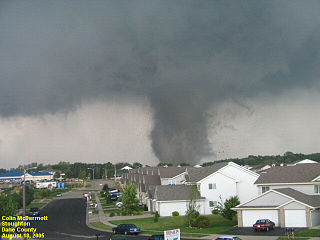
The Wisconsin tornado outbreak of 2005 was an outbreak of tornadoes that occurred primarily in southern Wisconsin on August 18, 2005. A system of storms unleashed a total of 28 tornadoes, 27 of which were confirmed in southern Wisconsin, and 1 confirmed in Minnesota. This outbreak set a new record for the most tornadoes observed in the state in a single day, breaking the previous record of 24 tornadoes set on May 8, 1988. The system generating the Stoughton tornado was also accompanied by many reports of severe winds and hail throughout the region. The Stoughton tornado was documented on an episode of The Weather Channel's Storm Stories.

The Tornado outbreak sequence of May 2004 was a series of tornado outbreaks that affected much of southern Ontario, the Central and Southern United States from east of the Rockies to the Mid-Atlantic States from May 21 to May 31, 2004. Particularly hard hit were the central Plains from Missouri to Iowa and the Ohio Valley. The Central Plains were hit by two significant outbreaks on May 22 and May 24, the first outbreak which produced a very large and violent tornado in Hallam, Nebraska. The Ohio Valley was affected by one of the largest tornado outbreaks ever during the Memorial Day weekend on May 29–30.

This page documents notable tornadoes and tornado outbreaks worldwide in 2006. Strong and destructive tornadoes form most frequently in the United States, Bangladesh, and Eastern India, but they can occur almost anywhere under the right conditions. Tornadoes also develop occasionally in southern Canada during the Northern Hemisphere's summer and somewhat regularly at other times of the year across Europe, Asia, Argentina, Brazil and Australia. Tornadic events are often accompanied with other forms of severe weather, including strong thunderstorms, strong winds, and hail.

This page documents the tornadoes and tornado outbreaks that occurred in 2007, primarily in the United States. Most tornadoes form in the U.S., although some events may take place internationally, particularly in parts of neighboring southern Canada during the summer season. Some tornadoes also take place in Europe, e. g. in the United Kingdom or in Germany.
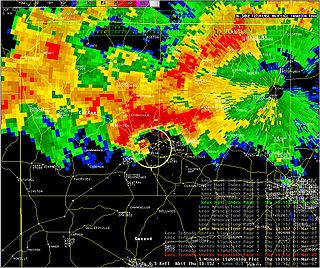
The tornado outbreak of February 28 – March 2, 2007 was a deadly tornado outbreak across the southern United States that began in Kansas on February 28, 2007. The severe weather spread eastward on March 1 and left a deadly mark across the southern US, particularly in Alabama and Georgia. Twenty deaths were reported; one in Missouri, nine in Georgia, and 10 in Alabama. Scattered severe weather was also reported in North Carolina on March 2, producing the final tornado of the outbreak before the storms moved offshore into the Atlantic Ocean.

The Late-October 1996 tornado outbreak was an unusual tornadic event that affected Nebraska, South Dakota and Minnesota on October 26, 1996. A total of 26 tornadoes would touched down on what turned out to be a record breaking late-season tornado outbreak.

The tornado outbreak of October 17–19, 2007 was a widespread tornado outbreak that took place across much of the eastern half of North America starting on October 17, 2007, and continuing into the early hours of October 19. The outbreak was also responsible for five deaths; three in Michigan and two in Missouri, plus many injuries. At least 64 tornadoes were confirmed including 16 on October 17 across six states including Texas, Oklahoma, Arkansas, Louisiana, Mississippi and Missouri with wind damage reported in Oklahoma, Kansas, Illinois, Iowa, Arkansas and Mississippi. On October 18, at least 48 tornadoes were confirmed across eight states including Florida, Alabama, Mississippi, Tennessee, Kentucky, Illinois, Indiana and Michigan, plus widespread straight line wind damage. Until 2010, this event held the record for largest tornado outbreak ever recorded in the month of October according to NOAA.
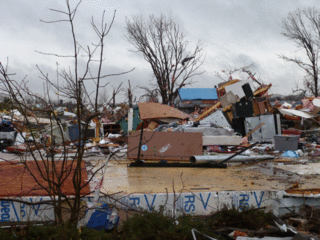
The January 2008 tornado outbreak was an unseasonably strong tornado outbreak that began on January 7, 2008 and continued for nearly four days, with the hardest hit area being southwestern Missouri, northwestern Arkansas, and the surrounding area. In addition, a strong supercell in northern Illinois and southeastern Wisconsin produced that region's first January tornadoes since 1967.
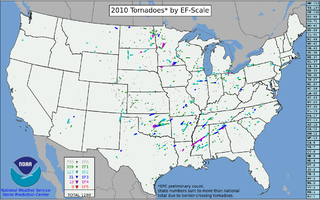
This page documents the tornadoes and tornado outbreaks of 2010. The majority of tornadoes form in the U.S., but they can occur almost anywhere under the right conditions. A lesser number occur outside the U.S., most notably in parts of neighboring southern Canada during the Northern Hemisphere's summer season, but are also known in South America, Europe, Asia, and Australia.
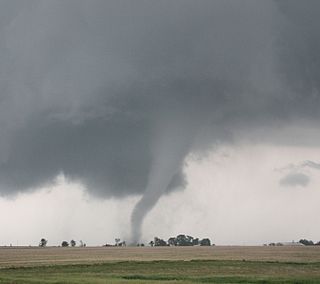
The tornado outbreak of June 5–6, 2010, was a tornado outbreak that affected the Midwestern United States and Great Lakes region, starting the weekend of June 5, 2010, and extending into the morning of June 6, 2010. At least 53 tornadoes were confirmed from Iowa to southern Ontario and Ohio as well as in northern New England. Seven people were confirmed dead in Ohio just outside Toledo, and one in Dwight, Illinois. Damage from the tornadoes in the United States totaled over $266 million.

This page documents the tornadoes and tornado outbreaks of 2012. Extremely destructive tornadoes form most frequently in the United States, Bangladesh, Brazil and Eastern India, but they can occur almost anywhere under the right conditions. Tornadoes also appear regularly in neighboring southern Canada during the Northern Hemisphere's summer season, and somewhat regularly in Europe, Asia, Argentina, and Australia.

This page documents the tornadoes and tornado outbreaks of 2014. Strong and destructive tornadoes form most frequently in the United States, Bangladesh, Brazil, and Eastern India, but they can occur almost anywhere under the right conditions. Tornadoes also appear regularly in neighboring southern Canada during the Northern Hemisphere's summer season, and somewhat regularly in Europe, Asia, and Australia.

This page documents the tornadoes and tornado outbreaks of 1964, primarily in the United States. Most tornadoes form in the U.S., although some events may take place internationally. Tornado statistics for older years like this often appear significantly lower than modern years due to fewer reports or confirmed tornadoes.

This page documents notable tornadoes and tornado outbreaks worldwide in 2020. Strong and destructive tornadoes form most frequently in the United States, Argentina, Brazil, Bangladesh, and eastern India, but can occur almost anywhere under the right conditions. Tornadoes also develop occasionally in southern Canada during the Northern Hemisphere's summer and somewhat regularly at other times of the year across Europe, Asia, Argentina, Australia and New Zealand. Tornadic events are often accompanied by other forms of severe weather, including strong thunderstorms, strong winds, and hail.

This page documents notable tornadoes and tornado outbreaks worldwide in 2021. Strong and destructive tornadoes form most frequently in the United States, Argentina, Brazil, Bangladesh, and Eastern India, but can occur almost anywhere under the right conditions. Tornadoes also develop occasionally in southern Canada during the Northern Hemisphere's summer and somewhat regularly at other times of the year across Europe, Asia, Argentina, Australia and New Zealand. Tornadic events are often accompanied by other forms of severe weather, including strong thunderstorms, strong winds, and hail.
References
- ↑ WJBK-TV 2, Detroit, MI
- ↑ 1997: The Year in Review
- ↑ WJBK-TV 2, Detroit, MI [ permanent dead link ]
- ↑ "Southeast Michigan Tornado Outbreak". NWS Detroit/Pontiac. NOAA. June 15, 2007. Retrieved January 1, 2014.
- ↑ "Southeast Michigan Tornado Outbreak". NWS Detroit/Pontiac. NOAA. June 15, 2007. Retrieved January 1, 2014.
- ↑ "Southeast Michigan Tornado Outbreak". NWS Detroit/Pontiac. NOAA. June 15, 2007. Retrieved January 1, 2014.
- ↑ "Southeast Michigan Tornado Outbreak". NWS Detroit/Pontiac. NOAA. June 15, 2007. Retrieved January 1, 2014.
- ↑ "Southeast Michigan Tornado Outbreak". NWS Detroit/Pontiac. NOAA. June 15, 2007. Retrieved January 1, 2014.
- ↑ "Southeast Michigan Tornado Outbreak". NWS Detroit/Pontiac. NOAA. June 15, 2007. Retrieved January 1, 2014.
- ↑ "Southeast Michigan Tornado Outbreak". NWS Detroit/Pontiac. NOAA. June 15, 2007. Retrieved January 1, 2014.
- ↑ "Southeast Michigan Tornado Outbreak". NWS Detroit/Pontiac. NOAA. June 15, 2007. Retrieved January 1, 2014.
- ↑ "Southeast Michigan Tornado Outbreak". NWS Detroit/Pontiac. NOAA. June 15, 2007. Retrieved January 1, 2014.
- ↑ "Southeast Michigan Tornado Outbreak". NWS Detroit/Pontiac. NOAA. June 15, 2007. Retrieved January 1, 2014.
- ↑ "Southeast Michigan Tornado Outbreak". NWS Detroit/Pontiac. NOAA. June 15, 2007. Retrieved January 1, 2014.
- ↑ "Southeast Michigan Tornado Outbreak". NWS Detroit/Pontiac. NOAA. June 15, 2007. Retrieved January 1, 2014.